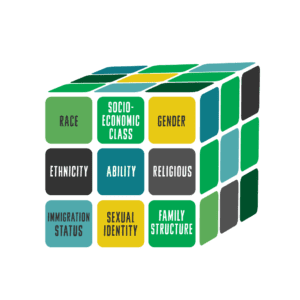التحيز الضمني
تم توثيق العنصرية الهيكلية والتمييز في التعليم بشكل جيد. توجد أبحاث أقل حول تقاطع الإعاقة والهويات الاجتماعية الأخرى مثل العرق والجنس. ومع ذلك ، فإن هذا الموضوع مهم لفهمنا للديناميكية داخل الفصول الدراسية لتكنولوجيا المعلومات والاتصالات.
One of the reasons that the intersectionality of disability and other social identities is less researched may be that within the educational systems, decision-makers who usually have a lot of discretion often believe that they are acting objectively based on facts. However, research shows that التحيزات الضمنية—that is, attitudes or stereotypes that affect our understanding and actions in an unconscious manner—exist in all aspects of education and disability diagnosis (identification, placement, and discipline).
Racial Implicit Bias and Disability Diagnosis
 راقب: Why Is Disability Representation So White?
راقب: Why Is Disability Representation So White?
(Note: The presenter speaks quickly, particularly during a montage within the video. You can press the settings icon on the bottom right-hand corner of the screen to choose a slower playback speed.)
Racial bias and white supremacy can lead to misdiagnosis, over-diagnosis of specific types of disabilities, and under-diagnosis of others. اقرأ المزيد عن ثقافة تفوق البيض في هذا المقال.
Studies have shown that Black and other minority students are
- more likely to be misdiagnosed;
- more likely to be educated in restrictive environments as opposed to the least restrictive environment called for by the Individuals With Disabilities Act (IDEA);
- likely to be over-diagnosed in high-incident categories of disability (which are more subjective) and under-diagnosed in low-incident categories (which are more objective).
يعد العدد الكبير بشكل غير متناسب من الطلاب السود الذين يعانون من تشخيص إعاقة ذاتية مقابل تشخيصات موضوعية مؤشرًا واضحًا على مدى تأثير التحيز الضمني في تشخيص إعاقة الطالب.
Gender Bias and Disability Diagnosis
في مثال آخر على التحيز الضمني الذي يظهر في التشخيص ، تظهر الأبحاث أن النساء غالبًا ما يتم استبعادهن من الأبحاث الطبية ويتم تشخيصهن بشكل خاطئ في كثير من الأحيان. والمثال الشائع على ذلك هو قلة تشخيص التوحد لدى النساء المرتبط بنقص البحث.
“The percentage served under IDEA who received services for autism was higher for male students (13 percent) than for female students (5 percent).”
—المركز الوطني للإحصاء التربوي
Author Maya Dusenbery spoke at the Society to Improve Diagnosis in Medicine Conference about the impact of implicit bias on women’s health stemming from two major gaps: a “knowledge gap” and a “trust gap.” In the article “Women More Often Misdiagnosed Because of Gaps in Trust and Knowledge,” Liz Seegert shares Dusenbery’s ideas from the conference. Dusenbery explained, “There’s a general lack of knowledge about women’s symptoms, bodies, and conditions that disproportionately affect them. That’s the legacy of decades of women being underrepresented or excluded from the research.”
Dusenbery went on to note that “there’s a lack of trust in women’s self-reports about what they’re experiencing, and a tendency to dismiss or psychologize complaints. That is part of the broader cultural stereotypes about women, and in particular, the صراع الهستيريا ، whose explanations ranged from a ‘wandering womb’ to demonic possession to witchcraft. Once Freud entered the picture at the end of the 19th century, hysteria became a catch-all psychological explanation for these unexplained complaints, which manifested as physical symptoms.”
Implicit Bias and Consequences in the Classroom
هناك أيضًا عواقب بمجرد تشخيص الطلاب. على سبيل المثال ، هناك نسبة عالية من الطلاب الذين تم تشخيص إعاقتهم ويتم فصلهم عن العمل وطردهم.
“Nearly 75 percent of special education students were suspended or expelled at least once.”
—Dustin Rynders, “Battling Implicit Bias in the IDEA to Advocate for African American Students With Disabilities”
Keeping in mind that during the 2018–19 school year, more than seven million students in the United States of America received special education services, we can begin to sense the grand scale of implicit bias and lack of awareness of how intersectionality can impact students with disabilities in ICT classrooms. Often the implicit biases held by classroom educators and administrators can compound upon one another, which can have consequences beyond students’ K-12 education.
Going back to the analogy of the Rubik’s Cube, consider that this resource has only cited very briefly how implicit biases often play out in diagnosis and treatment with two of so many possible identities.
 يتعلم
يتعلم يعكس
يعكس يكتشف
يكتشف



